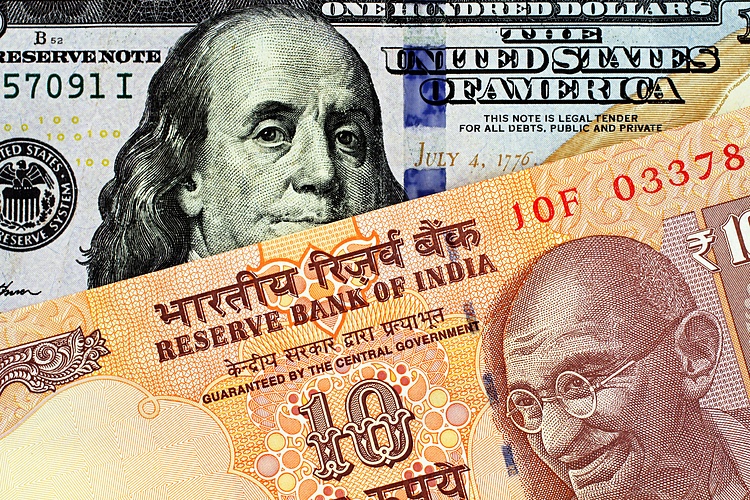- The Indian Rupee edges lower in Tuesday’s Asian trading hours.
- Outflows from Indian equities, higher oil prices and a stronger US Dollar undermine the INR.
- Traders await Fedspeak ahead of the RBI rate decision.
The Indian Rupee (INR) weakens on Tuesday amid the selling pressure from foreign funds and weak tone in the domestic markets. Additionally, the rise in crude oil prices and escalating geopolitical tensions between Israel and Iran contribute to the INR’s downside.
Traders will keep an eye on the speeches from the US Federal Reserve’s (Fed) Raphael Bostic, Phillip Jefferson and Susan Collins on Tuesday. Any dovish comments from the Fed officials could weigh on the Greenback and cap the downside for the local currency. On Wednesday, the Reserve Bank of India (RBI) interest rate decision will take center stage.
Daily Digest Market Movers: Indian Rupee looks fragile amid global challenges
- “We expect the rupee to trade with a negative bias on selling pressure from foreign funds and a weak tone in the domestic markets. Escalating tensions between Israel and Iran may further pressurize the rupee,” said Anuj Choudhary, Research Analyst at Sharekhan by BNP Paribas.
- India’s foreign exchange reserves rose $12.588 billion to a new all-time high of $704.885 billion for the week ended September 27, the Reserve Bank of India said on Friday.
- India’s Trade Minister Piyush Goyal said on Monday it is time for the INR to appreciate on the back of inflows in debt and equity markets.
- Federal Reserve Bank of St. Louis President Alberto Musalem stated on Monday that he supports more interest rate cuts as the economy moves forward on a healthy path. However, he emphasized that it is appropriate for the Fed to be cautious and not overdo easing monetary policy, per Reuters.
- Minneapolis Fed President Neel Kashkari said on Monday that the Fed welcomed the strong September jobs report, which indicates the firm economy. Kashkari added that the balance of risks shifted from “high inflation towards maybe higher unemployment.
Technical Analysis: USD/INR’s constructive outlook prevails
The Indian Rupee trades weaker on the day. The positive picture of the USD/INR pair remains intact, with the pair holding above the key 100-day Exponential Moving Average (EMA) on the daily timeframe. The further upside looks favorable as the 14-day Relative Strength Index (RSI) is located above the midline near 60.70.
The upper boundary of the rectangle and psychological mark near 84.00 act as a key resistance level for USD/INR. Any follow-through buying above this level could attract some buyers to the all-time high of 84.15, followed by 84.50.
On the downside, the first downside target to watch is 83.80, the low of October 1. Sustained bearish momentum could pave the way to the 100-day EMA at 83.66. The next contention level is seen at 83.00, representing the round mark and the low of May 24.
Indian Rupee FAQs
The Indian Rupee (INR) is one of the most sensitive currencies to external factors. The price of Crude Oil (the country is highly dependent on imported Oil), the value of the US Dollar – most trade is conducted in USD – and the level of foreign investment, are all influential. Direct intervention by the Reserve Bank of India (RBI) in FX markets to keep the exchange rate stable, as well as the level of interest rates set by the RBI, are further major influencing factors on the Rupee.
The Reserve Bank of India (RBI) actively intervenes in forex markets to maintain a stable exchange rate, to help facilitate trade. In addition, the RBI tries to maintain the inflation rate at its 4% target by adjusting interest rates. Higher interest rates usually strengthen the Rupee. This is due to the role of the ‘carry trade’ in which investors borrow in countries with lower interest rates so as to place their money in countries’ offering relatively higher interest rates and profit from the difference.
Macroeconomic factors that influence the value of the Rupee include inflation, interest rates, the economic growth rate (GDP), the balance of trade, and inflows from foreign investment. A higher growth rate can lead to more overseas investment, pushing up demand for the Rupee. A less negative balance of trade will eventually lead to a stronger Rupee. Higher interest rates, especially real rates (interest rates less inflation) are also positive for the Rupee. A risk-on environment can lead to greater inflows of Foreign Direct and Indirect Investment (FDI and FII), which also benefit the Rupee.
Higher inflation, particularly, if it is comparatively higher than India’s peers, is generally negative for the currency as it reflects devaluation through oversupply. Inflation also increases the cost of exports, leading to more Rupees being sold to purchase foreign imports, which is Rupee-negative. At the same time, higher inflation usually leads to the Reserve Bank of India (RBI) raising interest rates and this can be positive for the Rupee, due to increased demand from international investors. The opposite effect is true of lower inflation.
Read the full article here

